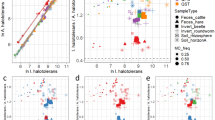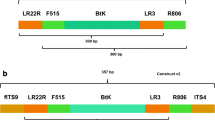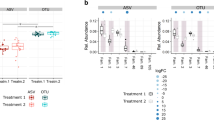Abstract
Metabarcoding is a powerful tool to characterize biodiversity in biological samples. The interpretation of taxonomic profiles from metabarcoding data has been hindered by their compositional nature. Several strategies have been proposed to transform compositional data into quantitative data, but they have intrinsic limitations. Here, I propose a workflow based on bacterial and fungal cellular internal standards (spike-ins) for absolute quantification of the microbiota in soil samples. These standards were added to the samples before DNA extraction in amounts estimated after qPCRs, to target around 1–2% coverage in the sequencing run. In bacteria, proportions of spike-in reads in the sequencing run were very similar (< 2-fold change) to those predicted by the qPCR assessment, and for fungi they differed up to 40-fold. The low variation among replicates highlights the reproducibility of the method. Estimates based on multiple bacterial spike-ins were highly correlated (r = 0.99). Procrustes analysis evidenced significant biological effects on the community composition when normalizing compositional data. A protocol based on qPCR estimation of input amounts of cellular spikes is proposed as a cheap and reliable strategy for quantitative metabarcoding of biological samples.






Similar content being viewed by others
Data availability
Raw FASTQ files and assembled sequences have been deposited in the NCBI under the BioProject PRJNA883611, with the accessions KHUY00000000 for fungal ITS2 data and KHUZ00000000 for bacterial 16S rRNA. Code and phyloseq objects with data were deposited in https://github.com/csmiguel/spike-in (Zenodo: 10.5281/zenodo.8302971).
References
Bengtsson-Palme J, Ryberg M, Hartmann M, Branco S, Wang Z, Godhe A, De Wit P, Sánchez-García M, Ebersberger I, de Sousa F et al (2013) Improved software detection and extraction of ITS1 and ITS2 from ribosomal its sequences of fungi and other eukaryotes for analysis of environmental sequencing data. Methods Ecol Evol 4:914–919
Bonk F, Popp D, Harms H, Centler F (2018) PCR-based quantification of taxa-specific abundances in microbial communities: quantifying and avoiding common pitfalls. J Microbiol Methods 153:139–147
Callahan BJ, McMurdie PJ, Rosen MJ, Han AW, Johnson AJA, Holmes SP (2016) DADA2: High-resolution sample inference from Illumina amplicon data. Nat Methods 13:581–583
Chen K, Hu Z, Xia Z, Zhao D, Li W, Tyler JK (2016) The overlooked fact: fundamental need for spike-in control for virtually all genome-wide analyses. Mol Cell Biol 36:662–667
Davis NM, Proctor DM, Holmes SP, Relman DA, Callahan BJ (2018) Simple statistical identification and removal of contaminant sequences in marker-gene and metagenomics data. Microbiome 6:226
Dopheide A, Xie D, Buckley TR, Drummond AJ, Newcomb RD (2019) Impacts of DNA extraction and PCR on DNA metabarcoding estimates of soil biodiversity. Methods Ecol Evol 10:120–133
Gloor GB, Macklaim JM, Pawlowsky-Glahn V, Egozcue JJ (2017) Microbiome datasets are compositional: and this is not optional. Front Microbiol 8:2224
Hardwick SA, Chen WY, Wong T, Kanakamedala BS, Deveson IW, Ongley SE, Santini NS, Marcellin E, Smith MA, Nielsen LK, Lovelock CE, Neilan BA, Mercer TR (2018) Synthetic microbe communities provide internal reference standards for metagenome sequencing and analysis. Nat Commun 9:1–10
Haro C, Anguita-Maeso M, Metsis M, Navas-Cortés JA, Landa BB (2021) evaluation of established methods for DNA extraction and primer pairs targeting 16S rRNA gene for bacterial microbiota profiling of olive xylem sap. Front Plant Sci 12:640829
Harrison JG, John Calder W, Shuman B, Alex Buerkle C (2021) The quest for absolute abundance: the use of internal standards for DNA-based community ecology. Mol Ecol Resour 21:30–43
Herlemann DP, Labrenz M, Jürgens K, Bertilsson S, Waniek JJ, Andersson AF (2011) Transitions in bacterial communities along the 2000 km salinity gradient of the Baltic Sea. ISME J 5:1571–1579
Jones MB, Highlander SK, Anderson EL, Li W, Dayrit M, Klitgord N, Fabani MM, Seguritan V, Green J, Pride DT, Yooseph S, Biggs W, Nelson KE, Craig Venter J (2015) Library preparation methodology can influence genomic and functional predictions in human microbiome research. Proc Natl Acad Sci U S A 112:14024–14029
Kõljalg U, Nilsson HR, Schigel D, Tedersoo L, Larsson KH, May TW, Taylor AFS, Jeppesen TS, Frøslev TG, Lindahl BD, Põldmaa K, Saar I, Suija A, Savchenko A, Yatsiuk I, Adojaan K, Ivanov F, Piirmann T, Pöhönen R et al (2020) The taxon hypothesis paradigm - On the unambiguous detection and communication of taxa. Microorganisms 8:1–24
Kong J, Liu X, Wang L, Huang H, Ou D, Guo J, Laws EA, Huang B (2021) Patterns of relative and quantitative abundances of marine bacteria in surface waters of the subtropical Northwest Pacific Ocean estimated with high-throughput quantification sequencing. Front Microbiol. https://doi.org/10.3389/fmicb.2020.599614
Lin Y, Gifford S, Ducklow H, Schofield O, Cassar N (2019) towards quantitative microbiome community profiling using internal standards. Appl Environ Microbiol 85:1–14
Lindner DL, Banik MT (2011) Intragenomic variation in the ITS rDNA region obscures phylogenetic relationships and inflates estimates of operational taxonomic units in genus Laetiporus. Mycologia 103:731–740
Liu P, Yang S, Yang S (2022) KTU: K-mer taxonomic units improve the biological relevance of amplicon sequence variant microbiota data. Methods Ecol Evol 13:560–568
Lofgren LA, Uehling JK, Branco S, Bruns TD, Martin F, Kennedy PG (2019) Genome-based estimates of fungal rDNA copy number variation across phylogenetic scales and ecological lifestyles. Mol Ecol 28:721–730
Martin M (2011) Cutadapt removes adapter sequences from high-throughput sequencing reads. EMBnet.journal 17:10–12
McMurdie PJ, Holmes S (2013) Phyloseq: an R package for reproducible interactive analysis and graphics of microbiome census data. PLoS One. https://doi.org/10.1371/journal.pone.0061217
McMurdie PJ, Holmes S (2014) Waste not, want not: why rarefying microbiome data is inadmissible. PLoS Comput Biol. https://doi.org/10.1371/journal.pcbi.1003531
Morton JT, Marotz C, Washburne A, Silverman J, Zaramela LS, Edlund A, Zengler K, Knight R (2019) Establishing microbial composition measurement standards with reference frames. Nat Commun. https://doi.org/10.1038/s41467-019-10656-5
Murali A, Bhargava A, Wright ES (2018) IDTAXA: a novel approach for accurate taxonomic classification of microbiome sequences. Microbiome 6:140
O’Donnell K, Cigelnik E (1997) Two divergent intragenomic rDNA ITS2 types within a monophyletic lineage of the fungus Fusarium are non-orthologous. Mol Phylogenet Evol 7:103–116
Oksanen J, Blanchet FG, Friendly M, Kindt R, Legendre P, McGlinn D, Minchin PR, O’Hara RB, Simpson GL, Solymos P, others (2020) Vegan: community ecology package. R package version 2.5-6. 2019
Paloi S, Luangsa-ard JJ, Mhuantong W, Stadler M, Kobmoo N (2022) Intragenomic variation in nuclear ribosomal markers and its implication in species delimitation, identification and barcoding in fungi. Fungal Biol Rev 42:1–33
Peres-Neto PR, Jackson DA (2001) How well do multivariate data sets match? The advantages of a procrustean superimposition approach over the Mantel test. Oecologia 129:169–178
Props R, Kerckhof FM, Rubbens P, De VJ, Sanabria EH, Waegeman W, Monsieurs P, Hammes F, Boon N (2017) Absolute quantification of microbial taxon abundances. ISME J 11:584–587
Quast C, Pruesse E, Yilmaz P, Gerken J, Schweer T, Yarza P, Peplies J, Glöckner FO (2012) The SILVA ribosomal RNA gene database project: improved data processing and web-based tools. Nucleic Acids Res 41:D590–D596
Quinn TP, Erb I, Gloor G, Notredame C, Richardson MF, Crowley TM (2019) A field guide for the compositional analysis of any-omics data. GigaScience 8:1–14
R Core Team (2022) R: a language and environment for statistical computing
Rodriguez-Mena S, Camacho M, de los Santos B, Miranda L, Camacho-Sanchez M (2022) Microbiota modulation in blueberry rhizosphere by biocontrol bacteria. Microbiol Res (Pavia) 13:809–824
Ruppert KM, Kline RJ, Rahman MS (2019) Past, present, and future perspectives of environmental DNA (eDNA) metabarcoding: a systematic review in methods, monitoring, and applications of global eDNA. Glob Ecol Conserv 17:e00547
Schoch CL, Seifert KA, Huhndorf S, Robert V, Spouge JL, Levesque CA, Chen W, Fungal Barcoding Consortium (2012) Nuclear ribosomal internal transcribed spacer (ITS) region as a universal DNA barcode marker for Fungi. Proc Natl Acad Sci USA 109:6241–6246
Shelton AO, Gold ZJ, Jensen AJ, D′Agnese E, Andruszkiewicz Allan E, Van Cise A, Gallego R, Ramón-Laca A, Garber-Yonts M, Parsons K, Kelly RP (2022) Toward quantitative metabarcoding. Ecology.: https://doi.org/10.1002/ecy.3906
Sidstedt M, Rådström P, Hedman J (2020) PCR inhibition in qPCR, dPCR and MPS-mechanisms and solutions. Anal Bioanal Chem 412:2009–2023
Smets W, Leff JW, Bradford MA, McCulley RL, Lebeer S, Fierer N (2016) A method for simultaneous measurement of soil bacterial abundances and community composition via 16S rRNA gene sequencing. Soil Biol Biochem 96:145–151
Stämmler F, Gläsner J, Hiergeist A, Holler E, Weber D, Oefner PJ, Gessner A, Spang R (2016) Adjusting microbiome profiles for differences in microbial load by spike-in bacteria. Microbiome 4:1–13
Stoddard SF, Smith BJ, Hein R, Roller BRK, Schmidt TM (2015) rrnDB: improved tools for interpreting rRNA gene abundance in bacteria and archaea and a new foundation for future development. Nucleic Acids Res 43:D593–D598
Taberlet P, Coissac E, Pompanon F, Brochmann C, Willerslev E (2012) Towards next-generation biodiversity assessment using DNA metabarcoding. Mol Ecol 21:2045–2050
Tedersoo L, Bahram M, Zinger L, Nilsson RH, Kennedy PG, Yang T, Anslan S, Mikryukov V (2022) Best practices in metabarcoding of fungi: from experimental design to results. Mol Ecol 31:2769–2795
Tsilimigras MCB, Fodor AA (2016) Compositional data analysis of the microbiome: fundamentals, tools, and challenges. Ann Epidemiol 26:330–335
White TJ, Bruns T, Lee S, Taylor J (1990) Amplification and direct sequencing of fungal ribosomal RNA genes for phylogenetics. PCR Protoc a Guid to methods Appl 18:315–322
Wright ES (2016) Using DECIPHER v2. 0 to analyze big biological sequence data in R. R J. 8:352–359
Yang L, Lou J, Wang H, Wu L, Xu J (2018a) Use of an improved high-throughput absolute abundance quantification method to characterize soil bacterial community and dynamics. Sci Total Environ 633:360–371
Yang R-H, Su J-H, Shang J-J, Wu Y-Y, Li Y, Bao D-P, Yao Y-J (2018b) Evaluation of the ribosomal DNA internal transcribed spacer (ITS), specifically ITS1 and ITS2, for the analysis of fungal diversity by deep sequencing. PLoS One 13:e0206428
Acknowledgements
Funding came from the IFAPA grant PP.AVA.AVA2019.034, financed by the Junta de Andalucía with 80% FEDER funds from the European Union. The Spanish Collection of Type Cultures (CECT; http://www.uv.es), Valencia, supplied Yarrowia lipolytica strain CECT 1240. MC-S has a postdoctoral contract from the Plan Andaluz de Investigación, Desarrollo e Innovación (PAIDI 2020). Part of the analysis was done in the High-Performance Computing cluster hosted by the Centro Informático Científico de Andalucía, CICA (https://www.cica.es/). Dr. Nieves Capote facilitated access to part of the laboratory equipment. María Camacho provided comments to the manuscript. Berta de los Santos and María Camacho and Luis Miranda led the field work.
Author information
Authors and Affiliations
Contributions
MC-S is responsible for all aspects of this work.
Corresponding author
Ethics declarations
Conflict of interest
The author declares no competing interests.
Additional information
Publisher’s note
Springer Nature remains neutral with regard to jurisdictional claims in published maps and institutional affiliations.
Supplementary information
ESM 1
Supplementary Information S1: preparation of fungus spike-in with Yarrowia lipolytica. (DOCX 15 kb)
ESM 2
Supplementary Information S2: Excel template for estimating input spike-in to add to biological samples from qPCR results. (XLSX 15 kb)
ESM 3
Supplementary Information S3: ITSx workflow and its comparison with the main dada2 workflow. (DOCX 38 kb)
ESM 4
Supplementary Information S4: Estimation in the dataset of the input spike-in to add to biological samples from qPCR results. (XLSX 24 kb)
ESM 5
Supplementary Information S5: Sequencing output, filtered reads, wild/spike-in reads, and alpha diversity for each sample. (XLSX 6 kb)
ESM 6
Supplementary Information S6: NCBI SRA and BioSample accessions for each sample. (XLSX 9 kb)
Rights and permissions
Springer Nature or its licensor (e.g. a society or other partner) holds exclusive rights to this article under a publishing agreement with the author(s) or other rightsholder(s); author self-archiving of the accepted manuscript version of this article is solely governed by the terms of such publishing agreement and applicable law.
About this article
Cite this article
Camacho-Sanchez, M. A new spike-in-based method for quantitative metabarcoding of soil fungi and bacteria. Int Microbiol (2023). https://doi.org/10.1007/s10123-023-00422-5
Received:
Revised:
Accepted:
Published:
DOI: https://doi.org/10.1007/s10123-023-00422-5




